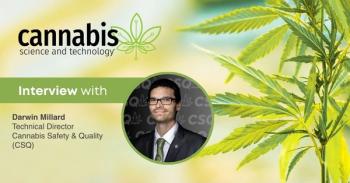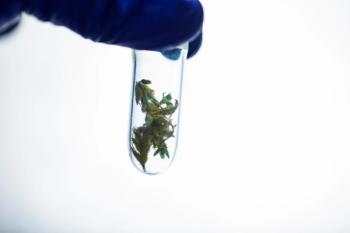
Cannabis Science and Technology
- April 2021
- Volume 4
- Issue 3
Why Dispensaries Need In-House Testing

Mislabeled cannabis medicines are an on-going problem; here we discuss appropriate technologies for cannabis dispensaries to do their own testing.
If cannabis were regulated like other medicines, the product you obtain at a dispensary would contain a label with an accurate statement of the amount of active pharmaceutical ingredient, a list of the inactive ingredients, and an expiration date. I present data below that shows up to 77% of dispensary products are mislabeled. This is alarming since it means cannabis patients are receiving the wrong dose of medicine, and cannabis consumers are being ripped off. To solve this problem, cannabis dispensaries need to do their own testing. I discuss appropriate technologies for this.
Think about your last trip to a pharmacy. What did you see? Everything imaginable on sale from aspirin to groceries to office supplies perhaps. And what did you see behind the counter as you were waiting to get your prescription filled? Probably rows of shelves with bottles of pills in them, and pharmacists and their assistants clad in nice white laboratory coats, looking for all the world like analytical chemists. But what was missing behind that counter? The fume hoods, chromatographs, and spectrometers you would normally see in an analytical chemistry laboratory. Why is this? Because thanks to the US Food and Drug Administration (FDA) every bottle behind that pharmacy counter contains a known amount of active pharmaceutical ingredients, a list of inactive ingredients (excipients), and an expiration date.
For example, a bottle of pain reliever I bought recently from my local pharmacy clearly states each tablet contains 200 mg ibuprofen, and there is a list of inactive ingredients in descending order of concentration. The label also says, “Store at 20 °C to 25 °C . . . avoid excessive heat above 40 °C.” The label also has a batch number on it, instructions for use, warnings, indications, contra-indications, and a sell by date.
How do we know what is in each tablet? How do we know the best storage conditions? How was the sell by date determined? Because the FDA compels pharmaceutical companies to perform in-house testing to make sure every bottle produced contains what is advertised. Additionally, each label will have a clear sell by date on it because chemistry tells us medicines degrade over time, and again thanks to the FDA stability studies were performed so we know how long it is safe take a specific medicine.
Contrast this with your last trip to your local cannabis dispensary, assuming they are legal where you live and you actually visit them. The lack of analytical equipment is similar to a normal pharmacy, but that is where the similarity ends. Pick up a cannabidiol (CBD) tincture bottle. It may list a few ingredients such as CBD extract, medium chain triglycerides (MCT) oil, and “flavoring” but that is probably it. A list of excipients is typically not there, nor should you expect to see a sell by date.
Cannabis medicines contain more than CBD and tetrahydrocannabinol (THC), they contain other cannabinoids, terpenes, and who knows what else. An extractor may formulate their tinctures with a distillate that is 90% cannabinoids, but what is in that other 10%? Fats? Waxes? Chlorophyll? Pesticides and heavy metals? Is any of what is in that 10% harmful to human health? We have no idea since there is little scientific work on the analysis of the noncannabinoid components of cannabis extracts and distillates. This means we are formulating cannabis medicines with poorly characterized ingredients, putting our patient’s health at risk.
The Dose Makes the Poison . . . and the Cure
The old adage “the dose makes the poison” (1) translated into chemical terms means that concentration matters. A little of something may be benign or even beneficial, whereas in large doses it can be fatal. For example, acetaminophen is an effective pain reliever and fever reducer, but in high doses is a liver poison (2). At minimum then, the label for any medicine needs to have an accurate statement of the amount of active pharmaceutical ingredient (API) present in each dose. And yet in the cannabis industry mislabeled medicines are an ongoing problem (3–5). In a recent paper, 62% of commercially available samples had incorrect CBD amounts on their labels (5). This same paper found that CBD degrades measurably over the course of 30 days, and that light and heat accelerate the degradation (5). This means the common sell by date of one year on cannabis products is probably wrong.
To supplement the data on CBD products, I performed a study on the labeling of marijuana buds. This involved purchasing 1/8 oz of buds of different strains at local dispensaries, noting the total THC value on the label, and then having the potency tested by high performance liquid chromatography (HPLC) at a California state licensed, International Organization for Standardization (ISO) certified laboratory (6). The results for the 14 different marijuana strains are shown in Table I.
The relative difference for each strain was calculated by subtracting the label value from the laboratory value and dividing by the laboratory value. The state of California considers a cannabis product mislabeled if the laboratory value is more than 10% relative different than the label claim. Other workers have used this same standard (5). Using this criterion, 10 out of 13 or 77% of the samples examined here were mislabeled. Note that for all strains the third party laboratory value is lower than the label claim. On average, the laboratory value is lower than the label value by 4.55 wt.% total THC, and on average the relative percent difference was 25.2%.
The fact that all strains studied are significantly lower than advertised is distressing. This means cannabis patients are receiving the wrong dose of medicine, and that cannabis consumers are not getting what they are paying for. All the samples had been harvested and packaged at least two months before this study. A possible explanation for these results is that the marijuana lost potency over time under the storage conditions used. Cannabis potency decrease over time has been observed before (7-10). Another possible explanation for these results is inter-laboratory error, where different cannabis laboratories obtain different numbers on the same samples. I have written on this problem extensively in previous columns and papers (11). If the vendor's in this study used a different third party laboratory than I did, it makes sense that we might get different results. Ultimately though these results are a condemnation of the state of California's laboratory testing certification program. This obviously needs to be reformed to prevent cannabis patients from receiving incorrect doses and cannabis consumers from being ripped off.
Imagine the uproar if 77% of the bottles in a batch of ibuprofen were mislabeled? There would be a hue and cry, gnashing of teeth, reams of bad publicity, calls for investigations, sanctions, and possible criminal prosecution. And yet this same exact scenario takes place regularly in the cannabis industry. Why do we tolerate this?
Why Do Dispensaries Need In-House Testing?
To prevent these problems dispensaries need to do their own in-house testing for these reasons.
1. Insure Customer Safety: Dispensaries are clearly selling mislabeled products. Medicines need to be labeled properly so patients get the proper dose. Dispensaries should test their stock before sale to make sure it is labeled properly.
2. Lower Liability: An incorrectly labeled product could cause harm to a consumer. If a dispensary tested its stock itself, it can make sure only correctly labeled medicines are sold, reducing liability.
3. Prevent Customers from Being Ripped Off: Cannabis consumers are entitled to get what they are paying for. If a jar of buds says it is 25 wt.% total THC, that is what the consumer should get. Based on the data above this is clearly not the case. If dispensaries tested their products before sale they could insure that only properly labeled products are sold, insuring consumers get what they pay for.
4. Prevent Dispensaries from
Being Ripped Off: Dispensaries set the price they pay suppliers based in part on potency. In many cases suppliers will provide certificates of analysis (COAs) from licensed laboratories to help determine price. However, there is nothing preventing suppliers from accidentally or intentionally giving the wrong COA to a potential buyer—and yes, I know this happens. Dispensaries need to protect themselves from being ripped off by doing on the spot potency tests of products before they buy them so they know what they are getting.
5. To Monitor Their Stock: Since we know that cannabinoids degrade over time (7–10), it makes sense for dispensaries to monitor what is on their shelves. This will prevent them from selling mislabeled or tainted products to their customers.
6. Reassure the Public: By doing their own analyses, dispensaries can assure the public they are getting what they pay for and the products being purchased are safe. Our industry will not realize its full potential until the public can have full confidence that cannabis medicines are safe and effective.
Should Dispensaries Set Up Their Own Testing Laboratories?
Setting up a cannabis analysis laboratory with all the equipment needed to test for pesticides, heavy metals, terpenes, and potency is a million dollar plus proposition. This is probably not practical for most dispensaries. However, given that in most instances the API is THC or CBD, having the ability to measure these analytes would be the best way to insure correct dosages and accurate label claims. Many third party laboratories use HPLC or gas chromatography (GC)to measure potency (11–14).
I have pointed out in previous columns that amongst the criteria to use when judging an analytical method are speed, accuracy, and cost (11). I have also pointed out that chromatography is accurate, but can be slow and expensive (11). Infrared (IR) spectroscopy on the other hand can offer equivalent accuracy but will always be faster, cheaper, and easier than chromatography (11). There exist IR spectroscopy-based cannabis analyzers that work on flower (15,16), extracts (17), distillates (18), and tinctures (19) that cost around $30k (20). This is not cheap, but probably much more within the budget of a typical cannabis dispensary than the cost of a chromatograph.
Conclusions
Mislabeled cannabis medicines are an ongoing problem in this industry. We found 77% of the products purchased at dispensaries are mislabeled. Mislabeled medicines mean patients are receiving incorrect doses, consumers are being ripped off, and dispensaries are exposed to significant litigation. For these reasons, dispensaries need to test their products before they sell them. Suggested potency testing technologies were discussed.
References
https://en.wikipedia.org/wiki/The_dose_makes_the_poison .https://en.wikipedia.org/wiki/Paracetamol .https://mjbizdaily.com/nearly-a-fifth-of-california-marijuana-products-failing-testing-standards/ .- M.O. Bonn-Miller, M.J.E. Loflin, B.F. Thomas, J.P. Marcu, T. Hyke, and V. Ryan, Journal of the American Medical Association 318, 1708 (2017).
- C. Mazzetti, E. Ferri, M. Pozzi, and M. Labra, Scientific Reports 10, 3697 (2020).
www.sclabs.com .- J. Fairbairn, J. Liebmann, and M. Rowan, Journal of Pharmacy and Pharmcacology 28, 1 (1976).
- I. Trofin, G. Dabija, D. Vaireanu, and L. Filipescu, Revista de Chimie (Bucharest) 63, 293 (2012).
- C. Lindholst, Australian Journal of Forensic Sciences 42, 181 (2010).
- B.C. Smith, Terpenes & Testing Magazine, Nov./Dec.(6), 48–51 (2017).
- B.C. Smith, Cannabis Science and Technology 2(2), 12-17 (2019).
- M.W. Giese, M.A. Lewis, L. Giese, and K.M. Smith, Journal of AOAC International 98(6), 1503 (2015).
- C. Giroud, CHIMIA Intl. Journal of Chemistry 56, 80 (2002).
- T. Ruppel and M. Kuffel, "Cannabis Analysis: Potency Testing Identification and Quantification of THC and CBD by GC/FID and GC/MS," PerkinElmer Application Note (2013).
- B.C. Smith, M. Lewis, and J. Mendez, “Optimization of Cannabis Grows Using Fourier Transform Mid-Infrared Spectroscopy,” PerkinElmer Application Note (2016).
- B.C. Smith, Cannabis Science and Technology 2(6), 10-14 (2019).
- B.C. Smith, Terpenes and Testing Jan.-Feb. 2018., Pg. 32.
- B.C. Smith, P. Lessard, and R. Pearson, Cannabis Science and Technology 2(1), 48–53 (2019).
- B.C. Smith, C.A. Fucetola, K. Ehrmantraut, and T. Hagan, Terpenes & Testing Sept./Oct. 2020, Pages 19-24.
www.bigsurscientific.com .
About the Columnist
Brian C. SMITH, PHD, is Founder, CEO, and Chief Technical Officer of Big Sur Scientific. He is the inventor of the BSS series of patented mid-infrared based cannabis analyzers. Dr. Smith has done pioneering research and published numerous peer-reviewed papers on the application of mid-infrared spectroscopy to cannabis analysis, and sits on the editorial board of Cannabis Science and Technology. He has worked as a laboratory director for a cannabis extractor, as an analytical chemist for Waters Associates and PerkinElmer, and as an analytical instrument salesperson. He has more than 30 years of experience in chemical analysis and has written three books on the subject. Dr. Smith earned his PhD on physical chemistry from Dartmouth College. Direct correspondence to:
How to Cite this Article
B. Smith, Cannabis Science and Technology 4(3), 10-12 (2021).
Articles in this issue
over 4 years ago
The Evolution of Ethanol Extraction Methods in Cannabisover 4 years ago
Gaining Deep Knowledge About Cannabis Cultivation: How and WhyNewsletter
Unlock the latest breakthroughs in cannabis science—subscribe now to get expert insights, research, and industry updates delivered to your inbox.




